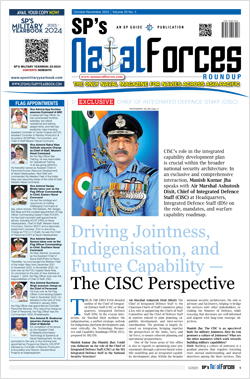INDIAN ARMED FORCES CHIEFS ON OUR RELENTLESS AND FOCUSED PUBLISHING EFFORTS

The insightful articles, inspiring narrations and analytical perspectives presented by the Editorial Team, establish an alluring connect with the reader. My compliments and best wishes to SP Guide Publications.

"Over the past 60 years, the growth of SP Guide Publications has mirrored the rising stature of Indian Navy. Its well-researched and informative magazines on Defence and Aerospace sector have served to shape an educated opinion of our military personnel, policy makers and the public alike. I wish SP's Publication team continued success, fair winds and following seas in all future endeavour!"

Since, its inception in 1964, SP Guide Publications has consistently demonstrated commitment to high-quality journalism in the aerospace and defence sectors, earning a well-deserved reputation as Asia's largest media house in this domain. I wish SP Guide Publications continued success in its pursuit of excellence.
- Global Partners Urged to Tap India's Shipbuilding Potential: Rajnath Singh at Samudra Utkarsh
- All about HAMMER Smart Precision Guided Weapon in India — “BEL-Safran Collaboration”
- India, Germany deepen defence ties as High Defence Committee charts ambitious plan
- G20 Summit: A Sign of Global Fracture
- True strategic autonomy will come only when our code is as indigenous as our hardware: Rajnath Singh
- India–Israel Joint Working Group Meeting on defence cooperation to boost technology sharing and co-development
First
Shipboard Firefighting
NRL scientists have designed a robot, which can move autonomously throughout the ship and fight fires

Scientists at the Naval Research Laboratory (NRL) have formed an interdisciplinary team to develop a humanoid robot that could fight fires on the next generation of combatants. A humanoid-type robot was chosen because it was deemed best suited to operate within the confines of an environment that was designed for human mobility and offered opportunity for other potential warfighting applications within the Navy and Marine Corps.
The firefighting robot, called the Shipboard Autonomous Firefighting Robot (SAFFiR), is being designed to move autonomously throughout the ship, interact with people, and fight fires, handling many of the dangerous firefighting tasks that are normally performed by humans. The humanoid robot should be able to manoeuvre well in the narrow passages and ladder ways that are unique to a ship and challenging for older, simpler robots to navigate.
The robot is designed with enhanced multi-modal sensor technology for advanced navigation and a sensor suite that includes a camera, gas sensor, and stereo infrared (IR) camera to enable it to see through smoke. Its upper body will be capable of manipulating fire suppressors and throwing propelled extinguishing agent technology (PEAT) grenades. It is battery powered that holds enough energy for 30 minutes of firefighting. Like a sure-footed sailor, the robot will also be capable of walking in all directions, balancing in sea conditions and traversing obstacles.
Another key element of the SAFFiR development is to allow damage control personnel and the robot to work cohesively as a team. Algorithms are being developed to allow autonomous mobility and decision-making by the robot as a team member. To enable natural interaction with a human team leader, the robot will have multi-modal interfaces that will enable the robot to track the focus of attention of the human team leader, as well as to allow the robot to understand and respond to gestures, such as pointing and hand signals. Where appropriate, natural language may also be incorporated as well as other modes of communication and supervision.





